
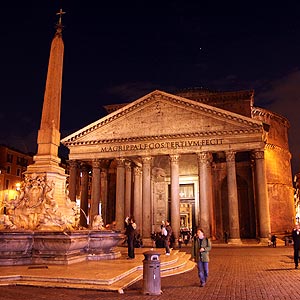
The Rotonda Square with the Pantheon at night is really beautiful and fantastic. Please enjoy the night of Rome together with the Navona Square.
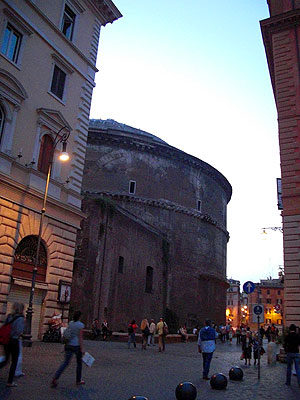
Pantheon is seen from the back like this.
It looks like a gas tank (a little bit ugly), but you can understand the original height of the building from this side.
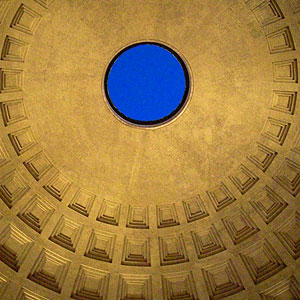
A blue sky in Rome is always beautiful. Especially, when you see it through the hole of the Pantheon (occhio) is exceptional.
Sometimes you see also birds fly. It's possible to enjoy a sense of integration of the nature and yourself.
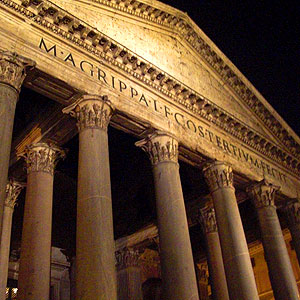
Here there is an inscription in Latin; "during the third consul, the Lucius's son Agrippa had built it".
Seeing from the front of the building in this way, you can enjoy a wonderful harmony with the triangular roof and the dome behind.
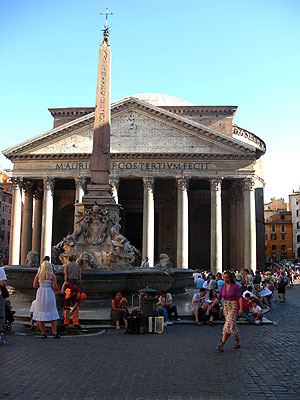
Obelisk of the Rotonda Square and the Pantheon
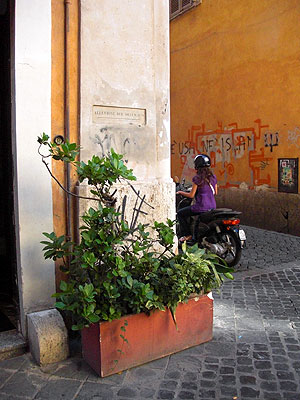
Try to walk down the street nearby. You can find a stone table which shows the height of the water at the time of flooding of the river Tevere in 19th century.
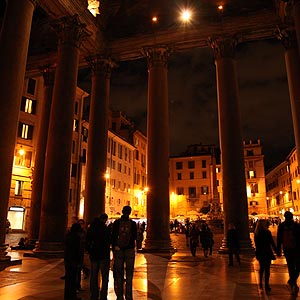
A view from inside the Pantheon. The Rotonda Square can be seen through the columns. At night the whole square becomes lighted up. It's wonderful.
The word Pantheon means "Temple dedicated to every god" in Greek. Today Italy is overwhelmingly Catholic country. However this building had been originally the Roman temple to honor Gods. Agrippa, the first Roman Emperor Augustus's brain had ordered in 25 BC.
The original Pantheon was burned about 100 years later (80 AD). Then the emperor Hadrian had rebuilt it from 118 AD. Practically we can see this second Pantheon now.
On the triangular part of the roof of the Pantheon, there is an inscription in Latin as follows: M. AGRIPPA LF COS TERTIUM FECIT (Lucius's son Agrippa had built it during the third consul).
M. AGRIPPA means Agrippa (Marcus Vipsanius Agrippa) mentioned above. Then L means Agrippa's father Lucius. F means FIGLIO (son).
This inscription shows that the emperor Hadrian had respected the first builder Agrippa.
Gradually the faith for Roman Gods had faded away and the faith of people became Christianity. Although this Pantheon had been originally built as a Roman temple, to protect its mystical beauty, the Christians had reused it into a Catholic church without destroying the architecture.
The structure of this Pantheon can be explained simply: a combination of a triangle, a square and a sphere. Put a giant sphere into a big cube, and put a triangular roof in front. You can get an approximate shape of the building. Behind the triangular roof the top of the sphere should be seen. In addition, gape a big hole in the top.
The effect of this hole to the inner space of the building is enormous. It's quite overwhelming. The highlight of the Pantheon would be this hole. You can be immersed in indescribable emotion just looking at the sun light shining through the hole.
This hole has a diameter of 9 m and is called the "occhio (eye)" of the Pantheon. It's often used the Latin word "Oculus". The round form is considered a symbol of infinity and ubiquity. I wonder how they realized a roof of this particular form at that time without modern technology in the short term (10 years).
One theory says; first of all, the cylindrical building had been built. Then they had filled this cylinder with a mixture of gold and the soil. After that, they had used this soil as scaffolds and put a dome of pumice stone on it as a roof. At last, the authority had permitted citizens to take the gold freely. Therefore, a cavity of the inside of the Pantheon had been achieved very rapidly. At that time the neighborhood of the Pantheon (especially the Rotonda Square in front) had been filled with free markets and people. The pope Alessandro VII had prohibited to open the markets to avoid too much bustle. Therefore, there would have been many poor people here, and this legend theory about the gold would be a truth.
In the mid of the 19th century, the river Tevere often caused flooding. And this square often sank under the water. Still now, one of the walls surrounding the Rotonda Square keeps a stone tablet recording the highest water level at that time. The name of this square, Rotonda in Italian means a round, and Ritonna is Roman dialect.
There is a Roman saying like this:
Chi va a Roma e nun vede la Ritonna asino va e asino ritorna.
"Who travels to Rome and doesn't visit the Pantheon, coming fool and leaving fool."
It represents an irony of Roman people as well as their pride and respect to the Pantheon, symbol of the Rome.
The Pantheon has been loved and protected by many Romans. However, there were also arrogant people. One of them is Urbano VIII of the Barberini family. He took away all of bronze decorations from the front of the Pantheon and converted into 80 cannons to set up in Castel S. Angelo.
After removed the parts of the building, he put some iron doors and pink pillars inside. Those strange additional ornaments damage the harmony of the antique building.
From the late of 19th century, they started to burry some famous persons here. Like a famous artist Raphael, the king of Rome Vitorrio Emanuele II and Umberto I etc. In addition, there are many masterpieces of renowned artists like Caravaggio, Bernini, Velasquez, Vanvitelli and Canova.
It's also held a Catholic ceremony "Rosa d'Ora" on the Pentecost Day once a year. To give an honor to the people who contributed to the Catholic Church, 700 million petals of red roses are thrown from the dome. Once this tradition was lost, but from 1995 it was restarted. A lot of people saw this beautiful sight also in 2010. Don't miss it! Rosa d'Ora itself can be also seen in other Catholic churches, but in the Pantheon you can admire a beautiful scene of red petals falling from the hole of 43.2m high. 43.2m is also a diameter of this dome, and indeed it's 1 m bigger than the cupola of St. Peter in Vatican.
Please enjoy by yourself the shape which boasts simple yet overwhelming presence. Its strength under the dome is telling architectural beauty.
A round blue sky through the Oculus will be surely one of the most beautiful memories of Rome.
As there is a saying "Who leave Rome without seeing the Pantheon is fool", don't miss this beautiful building.
I recommend a daytime visit under the blue sky. However, in the evening various concerts are held occasionally.
Be careful to street performers, sometimes a bad clown tries to steal your purse!
| Name | Pantheon |
| Address | Piazza della Rotonda, Roma-Italy |
| Tel. | +39 06 6830 0230 |
| Closed | None |
| Opening Hours | 8:30-19:30 Sunday: 9:00-18:00 Holiday: 9:00-13:00 |
| price | Free |
| Notes | Mass times: Saturday 17:00, Sunday10:30 Sleeveless top, dresses and the like are not counted in the dresscode of the church |
| Map | View Larger Map |
Pantheon is a beautiful Roman temple architecture, which also Michelangelo had admired as a "Design of Angels". The old temple of 2000 years ago is still remaining intact. Including the Pantheon square, the night lighting is must see. We Amoitalia recommend visiting from "Trevi Fountain", "Pantheon" to "Navona Square" with beautiful lighting after sunset.